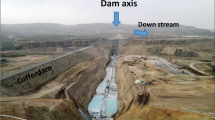Abstract
This study evaluates the relationships between El Niño–Southern Oscillation (ENSO) indices and South Florida hydrology and proposes applications to water management decision making. ENSO relations to the Upper Kissimmee Basin rainfall, watershed for Lake Okeechobee, and cumulative sea surface temperature (SST) anomalies at Niño 3.4 were evaluated. Additionally, relationship between ENSO and Lake Okeechobee inflows, Arbuckle Creek and Josephine Creek flows were analyzed. Hydrology of the northern watersheds of the South Florida water management system is linked to ENSO events. Dry season (November–May) rainfall and flows are higher than average during El Niño years and lower during La Niña years, at the 90% confidence level or higher. The relationship is strongest when the ENSO event is strong as shown with analysis of correlation. ENSO prediction has more certainty than hydrologic prediction for a region. Identifying ENSO and hydrologic relationships can aid water management decision making by providing a lead-time of months to mitigate drought or flood impacts. The ENSO tracking method, which was published in a previous study, is presented to track ENSO strength and event type to provide supplemental outlook on dry season rainfall for Lake Okeechobee operations. Lake Okeechobee, which is the main storage in the South Florida water management system, is regulated by a schedule with a limited band of stage fluctuation because of susceptibility of the Herbert Hoover Dike to wave erosion and seepage at high stages. An early decision making approach to storage management with respect to ENSO related hydrology, is presented based on tracking the strength of ENSO events.
Similar content being viewed by others
References
Abtew W, Melesse AM (eds) (2008) Proceedings of the 2008 workshop on hydrology and ecology of the Nile River Basin under extreme climatic conditions. Aardvark Global Publishing, Salt Lake City, UT
Abtew W, Melesse AM, Dessalegne T (2009) El Niño Southern Oscillation link to the Blue Nile River Basin hydrology. Hydrol Process. doi:10.1002/hyp.7367
Arpe K, Bengtsson N, Golitsyn GS, Mokhov II, Semenov VA (2000) Connection between Caspian Sea level variability and ENSO. Geophys Res Lett 27(17):2693–2696
Bromwell LG, Dean RG, Vick SG (2006) Report of expert review panel technical evaluation of Herbert Hoover Dike Lake Okeechobee, Florida. Prepared for South Florida Water Management District. BCI Engineers and Scientists, Lakeland, Florida
Changnon SA, Kunkel KE (1999) Rapidly expanding uses of climate data and information in agriculture and water resources: causes and characteristics of new applications. Bull Am Meteorol Soc 80(5):821–830
CPC (2008) Teleconnection introduction. Available at http://www.cpc.ncep.noaa.gov/data/teledoc/teleintro.shtml. Accessed 9 September 2008
Enfield DB, Nunez AM, Trimble PJ (2001) The AMO and its relationship to rainfall and river flow in the continental US. Geophys Res Lett 28(10):2077–2080
Hammer GL, Nicholls N, Mitchell C (eds) (2000) Applications of seasonal climate forecasting in agricultural and natural ecosystems. Kluwer Academic Publishers, Dordrecht, The Netherlands
Kahya E, Dracup A (1993) U.S. streamflow patterns in relation to the El Niño/Southern Oscillation. Water Resour Res 29(8):2419–2502
Kerr R (2000) A north Atlantic climate pacemaker for the centuries. Science 288(5473):1984–1986
Klopper E (1999) The use of seasonal forecasts in South Africa during the 1997/98 rainfall season. Water SA 25(3):311–313
Mauas PJD, Flamenco E, Buccino AP (2008) Solar forcing of the stream flow of a continental scale South American River. Phys Rev Lett 101(16):168501-1–168501-4
NOAA (2009) Cold and warm episodes by season. Available at http://www.cpc.ncep.noaa.gov/products/analysis_monitoring/ensostuff/ensoyears.shtml. Accessed 21 September 2009
Null J (2009) El Niño and La Niña years and intensities. Available at http://ggweather.com/enso/oni.htm. Accessed 21 September 2009
Obeysekera J, Trimble P, Neidrauer C, Pathak C, VanArman J, Strowd T, Hall, C (2007) Consideration of long-term climatic variability in regional modeling for SFWMD planning and operations. In: 2007 South Florida Environmental Report. South Florida Water Management District, West Palm Beach, FL
Pagno TC, Hartmann HC, Sorooshian S (2002) Using climate forecast for water management: Arizona and the 1997–1998 El Niño. J Am Water Resour Assoc 37(5):1139–1153
Patt A, Suarez P, Gwata C (2005) Effects of seasonal climate forecast and participatory workshops among subsistence farmers in Zimbabwe. PNAS 102(35):12623–12628
Pulwarty RS, Melis TS (2001) Climate extremes and adaptive management on the Colorado River: Lessons from the 1997–1998 ENSO event. J Environ Manag 63:307–324
Ropelewski CF, Halpert MS (1986) North American precipitation and temperature patterns associated with the El Niño/Southern Oscillation (ENSO). Mon Weather Rev 114:2352–2362
Snedecor GW, Cochran WG (1980) Statistical methods. Iowa State University Press, Ames
Thomas BE (2007) Climatic fluctuations and forecasting of streamflow in the lower Colorado River Basin. J Am Water Resour Assoc 43(6):1550–1569
Trimble P, Santee ER, Neidrauer C (1997) Including the effects of solar activity for more efficient water management: an application of neural networks. Special Report, South Florida Water Management District, West Palm Beach, FL
Vincente-Serrano SM (2005) El Niño and La Niña influence on drought at different timescales in the Iberian Peninsula. Water Resour Res 41:W12415
Wernstedt K, Hersh R (2002) Climate forecasts in flood planning: promise and ambiguity. J Am Water Resour Assoc 38(6):1703–1713
Zhang EY, Trimble P (1996) Predicting effects of climate fluctuations for water management by applying neural networks. World Resour Rev 8(3):1–17
Zhang J, James RT, McCormick P (2009) Chapter 10: Lake Okeechobee Protection Program—state of the lake and watershed. In: 2010 South Florida Environmental Report, vol I. South Florida Water Management District, West Palm Beach, FL
Author information
Authors and Affiliations
Corresponding author
Rights and permissions
About this article
Cite this article
Abtew, W., Trimble, P. El Niño–Southern Oscillation Link to South Florida Hydrology and Water Management Applications. Water Resour Manage 24, 4255–4271 (2010). https://doi.org/10.1007/s11269-010-9656-2
Received:
Accepted:
Published:
Issue Date:
DOI: https://doi.org/10.1007/s11269-010-9656-2




